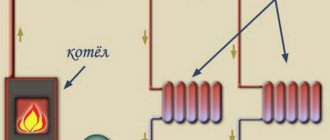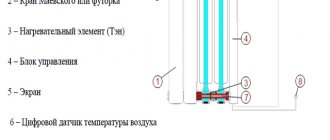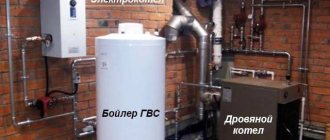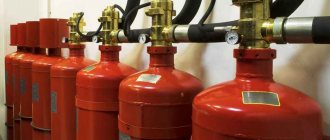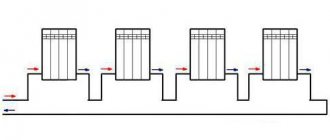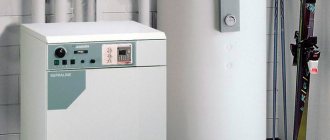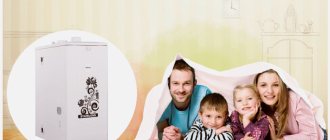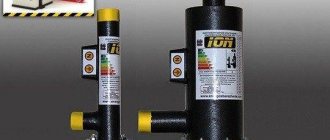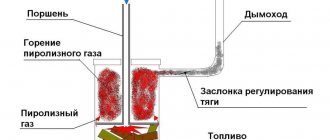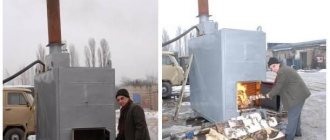Rating: 461
At the moment, a huge variety of methods of heating rooms are used. Most often, the choice of owners falls on a diesel heating boiler. From the scientific side of the issue, the boiler is liquid fuel, and got its name due to the type of fuel the working process takes place on.
Principle of operation
Structurally and in terms of the method of operation, diesel boilers are no different from their gas counterparts. Burners of a similar configuration, a similar control method, heat exchangers and a chimney are used to remove combustion products.
The same technologies are used, for example, condensing boilers using secondary heat.
However, there are also differences. Diesel fuel is a liquid that does not want to burn on its own. It must be passed through nozzles under high pressure, mixed forcibly with a large amount of air saturated with oxygen, and then fed in a finely dispersed state into the combustion chamber. Under the influence of electrode ignition, the fuel mixture ignites, releasing the necessary heat.
Diesel burners in heating boilers can be built-in or external. Historically, the first diesel boilers were built on the principle of atmospheric gas burners, although in fact they could not be like that; the injection of fuel and air was forced in any case, and the combustion chamber was closed.
Mono-torch diesel burners, made in the form of a separate unit, which is attached to the body of the heating boiler or located inside it, are now becoming very popular.
This is a separate device designed to prepare a fuel mixture with complete combustion control.
Diesel burners can be:
- single-stage;
- two-stage;
- modulated.
This indicates the burner’s ability to regulate power. Single-stage designs operate only in two on/off modes. During operation, they deliver all the power declared and set by the settings. The coolant temperature is adjusted by periodic operation of the burner.
In two-stage burners it is possible to set an intermediate power value without reconfiguring the equipment. The burner can operate at full power or at a level of 50-70%.
Modulating burners have a large number of preset combustion modes.
Without delving into the technical jungle, two-stage and modulating burners are much more complex in design and higher in cost than single-stage ones, despite the fact that the benefit from multi-stage adjustment is noticeable only for ultra-high-capacity boiler equipment of 0.5 megawatts and above.
Diesel boiler Buderus
The best option for heating a house is single-stage burners and boilers equipped with them with a power of up to 150 kW. From 80 to 400 kW, it makes sense to choose a boiler with a two-stage power setting in order to benefit from boiler operation in the off-season and at low loads.
The benefits mainly concern the reduction of depreciation costs and the reduction in coolant temperature variation associated with a lower frequency of burner startup.
Review of diesel boilers
Liquid fuel units are represented by a design that operates on available types of resources and liquefied gas. Diesel oil is the most popular type of fuel. To store it, any container that may be located in close proximity to the boiler is sufficient. This allows you to conveniently organize the space: the boiler can be installed in the basement, and the container with diesel fuel can be removed outside of it. The main advantage of the system is autonomy and constant heat in the house , depending solely on the volume of the fuel tank.
Heating units are sold in steel and cast iron versions. For use in a country house, preference should be given to a cast iron boiler. The models are presented in two versions: floor-mounted and wall-mounted. The power of cast iron structures ensures reliable positioning and installation on a plane.
Wall-mounted models are categorical about the quality of diesel fuel, and are not sales leaders.
The nice steel case is made of hardened steel, has a heat-insulating layer that allows maximum heat retention and prevents the walls from heating up.
Maintenance comes down to monitoring the burner and nozzle that sprays fuel, cleaning the chimney, but professional services cost a decent amount. According to the method of heat generation, diesel boilers are divided into classic and condensing types. A condensation system is considered more technologically advanced, allowing productive use of the energy of the unit.
Heating with diesel fuel
The main differences and advantages of diesel heating boilers:
- Diesel fuel is not supplied through pipelines; it is stored in prepared containers directly next to the heating boiler. This gives a greater degree of autonomy.
- Compared to gas cylinders, safety is much higher, since there is no risk of self-ignition or explosion during storage.
- Diesel burners used in boilers are, by definition, energy-dependent, since the fuel pump, air injection fan and automation unit operate on electricity.
Diesel burners are often produced with the ability to use not only diesel fuel, but also used engine oil, which further reduces home heating costs and also reduces the requirements for the quality of the fuel used.
However, good operation of a diesel burner can only be expected with timely maintenance.
More and more models are appearing on sale that can run on diesel fuel, waste oil and natural gas. Such versatility is achieved either by the ability to quickly replace the entire burner from diesel to gas, or by using a universal burner that can only use a different type of fuel with reconfiguration.
However, due to design features, such versatility has a negative impact on the efficiency of the boiler and its durability.
To finally determine whether a diesel boiler is suitable or not, you should find out the typical fuel consumption and economic efficiency of the equipment, as well as familiarize yourself with the different types of heating boilers offered on the boiler equipment market.
Design features of liquid fuel boilers
A diesel fuel boiler in its design and principle of operation resembles a gas unit, but has a number of characteristic features. Regardless of the manufacturer, the design of most liquid fuel heat-generating devices includes the following basic elements:
- the combustion chamber;
- heat exchanger;
- diesel burner;
- fuel pump;
- control automation;
- smoke exhaust system.
Depending on the type of boiler and manufacturer, all main elements can be assembled either in a single housing or have a separate design.
The combustion chamber of an oil-fuel boiler most often has the shape of a cylinder and has reliable thermal insulation on the outside.
Heat exchangers in most cases are recuperators in which the heat of hot gases is transferred to the coolant through a dividing wall. The materials used to manufacture heat exchangers for liquid fuel units are: copper, cast iron, plain and high-alloy steel.
For example, a double-circuit diesel boiler has two heat exchangers at once, and they can be made of different materials. One coolant circuit heats the house, the second provides the household with hot water.
On the market of heating equipment for domestic use, you can find diesel equipment, which includes two types of burners: for diesel fuel and for gas. This makes it possible for the boiler to operate on various types of fuel - both petroleum products and gas. It is quite possible to replace the burner in a combined boiler yourself, but connecting it necessarily requires the presence of gas service technicians and the availability of permits.
Liquid fuel burners can have different designs. The main thing is that the nozzle ensures correct (cone-shaped) spraying of fuel at the desired angle and its efficient combustion.
To ensure fuel combustion, the following elements are required:
- fuel pump;
- nozzle;
- fine filter;
- pressure gauge;
- coolant temperature sensor;
- Remote Control.
A single-circuit diesel boiler is intended only for heating and has a less complex automation system compared to a double-circuit unit. Almost all household diesel thermal units are volatile and require connection to a stationary or autonomous power supply system, like electric boilers. When automatic devices are connected, the operation of liquid fuel units does not require human intervention. It is only necessary to replenish fuel reserves on time and carry out periodic maintenance of the equipment.
The smoke exhaust system of an oil-fuel boiler can have either a conventional form, when air is sucked into the burner directly from the room, or have a coaxial structure. The coaxial chimney provides air flow into the combustion chamber from the street, simultaneously heating it. Such well-known manufacturers as Buderus and Kiturami prefer coaxial designs.
Fuel consumption
Diesel boilers have a strictly defined fuel consumption parameter. This parameter is configured and set at the time of entry into explantation and depends on the target burner power.
The consumption is calculated in kilograms of fuel consumed per hour for operation at full power or at half power for two-stage burners.
To understand how much diesel fuel is required for the entire heating season, you need to divide the total heat loss by the boiler power , determining the clean operation time of the burner, and then calculate the total fuel consumption.
Viessmann floor standing boiler
Theoretical calculations can only be made approximately. The heating season is divided into weekly periods and for each a statistical value of the average outdoor temperature is selected.
Thermal engineering calculation of a house allows you to find out the thermal resistance of the structure. Heat loss at home for each time period is calculated taking into account the difference in temperature outside and the target temperature for the heated room. Summing up the results for each period, we obtain the total heat loss of the house for the entire season.
An approximately 100m2 house with good thermal insulation may require 4 to 10 tons of diesel depending on the target room temperature.
Diesel fuel consumption for heating a house
Another burning question that worries people before purchasing equipment. To find out the average fuel consumption, you need to again turn to mathematical calculations.
First you need to calculate the total area of the heated premises, the value is taken in square meters. Now remember that heating 10 m2 will require 1 kW of energy. In total, to heat a building with an area of 100 m2 will be required .
To generate the required amount of energy, the boiler will have to consume 1 liter of fuel. However, it is important to consider that the building will be heated around the clock, so the energy consumption will be 240 kW or 24 liters of diesel fuel per day.
| House area, m2 | Boiler power, kW | Maximum fuel consumption, kg/h |
| 100 | 5-12 | 3,2 |
| 130 | 6-16 | 4,7 |
| 160 | 6-20 | 6 |
| 200 | 7-24 | 7,6 |
| 220 | 8-25 | 7,9 |
| 270 | 10-32 | 8,9 |
| 370 | 18 and over | from 14 |
Wall
Wall-mounted diesel boilers are perfect for heating a small house, without taking up much space for the boiler room.
Due to safety requirements, you will still have to organize a boiler room, however, with the compact size of the boiler itself, it is enough to allocate a small room.
The burner in wall-mounted diesel boilers is built-in and is more similar in design to a gas one with a closed combustion chamber.
The walls of the combustion chamber and the heat exchanger are made of steel, at best it is alloy steel with good resistance to corrosion and acids. However, a wall-mounted boiler still cannot boast of durability. The approximate service life will be 12-15 years, after which major repairs or replacement will be required.
An important part of the system is the heat exchanger
Heat exchanger of a diesel boiler
The breakdown of the same burner is not as important as the current condition of the heat exchanger. Heating occurs inside this part of the boiler, and it is advisable to select the best material for it.
Heat exchangers are made of either steel or cast iron. And it would be better to use the second option, since cast iron is more resistant to condensation, as well as corrosion.
Heat exchangers can last up to 50 years, which is a very good investment. The same cannot be said about burners. These elements are not difficult to replace with the help of a household mechanic. And such repairs are cheap.
Floor
The vast majority of diesel boilers are floor-standing. This makes it possible not to look at the weight of equipment and focus primarily on durability and efficiency.
The cast iron walls of the combustion chamber and heat exchanger provide enormous survivability of the boiler. On average, you can expect 50 years of trouble-free operation without breakdowns on the boiler body, even if fuel with a high sulfur content is used.
Herz boiler with boiler
Steel boiler walls, even acid-resistant alloy steel, can become leaky over time. The service life of the boiler will directly depend on the quality of the fuel and burner settings to reduce the amount of harmful emissions.
Single-circuit and double-circuit
Single-circuit boilers are focused only on heating the house. The heat exchanger is designed in such a way that the maximum thermal energy from the combustion of diesel fuel is transferred to the coolant.
, double-circuit heating boilers are capable of preparing hot water for domestic needs . Based on their design and operating principle, there are several types of double-circuit boilers:
- with flowing direct heating of water;
- flow-through indirect burning;
- with built-in indirect heating boiler.
In the first case, hot water is supplied to a heat exchanger, which is directly heated by the heat in the combustion chamber.
This method allows you to quickly prepare water for domestic needs, with virtually no effect on the operation of the heating circuit.
Bittermic heat exchangers are used, in which the channel is divided into two cavities or two separate heat exchangers located one above the other. However, due to significant temperature changes, when still cold water enters the heat exchanger, the wall material can quickly become unusable and burst. The problem is only partially solved by preheating the water in the coil.
There is a significant drawback to the first type of boilers. When the hot water supply circuit is turned on, the coolant flow in the heating circuit stops. While the consumer is using hot water, the heating radiators begin to gradually cool down.
Flow-through indirect heating means that a water-to-water plate heat exchanger is installed at the outlet of the heating boiler. Coolant flows through one circuit, and water through the second. Part of the heat from the heating circuit is spent on DHW operation. With the correct choice of burner power, such heating of water does not affect the operation of the heating.
The built-in indirect heating boiler allows you to prepare in advance a significant volume of water for domestic needs, gradually removing energy from the heating boiler.
Fuel tank for boiler
For continuous operation of the heating system, it is important to always keep a significant supply of diesel fuel or waste oil close to the boiler.
For this, containers with a volume of 4-10 cubic meters are used. According to fire safety requirements, a container with diesel fuel must be buried in the ground below the freezing level so that during the heating season the fuel cannot thicken to such an extent that the fuel pump cannot pump it to the boiler.
The ideal material for the container is stainless steel, especially in the case of underground storage. However, there is a significant selection of polymer containers of various sizes and Eurocubes on sale, which can also be effectively used for storing fuel.
According to the advice of manufacturers and service companies, it is advisable to use a container with a volume of diesel fuel sufficient for at least a third of the heating season, while with the onset of cold weather it is important to fill in freeze-resistant diesel fuel or additives that can increase the fluidity of the fuel.
Technical standards for installing a diesel boiler
Installation of a diesel boiler does not require special permission, but installation requires compliance with a number of rules.
- Ceilings in the boiler room must have a minimum height of 2.5 m .
- Installation in the basement is only permissible if there is a separate exit to the street.
- A unit with a power of 350 kV is allowed to be installed autonomously from a common room and away from window and door openings.
- To comply with fire safety, it is necessary to bury the fuel in the ground . This solution will save diesel fuel from low temperatures, which negatively affect the viscosity of the fuel, which puts a strain on pumping and increases energy consumption.
Organizing storage on the surface requires a container protected from sunlight. The ideal option would be stainless steel storage . To heat your home, you should purchase a container with a volume of 4 - 10 tons . Installing equipment involves additional financial costs to create a storage facility. This is the most difficult part of the installation, which determines further safety of use.
Fuel filter
An essential component of a diesel heating boiler. Third-party impurities can instantly damage the burner nozzles, which threatens major repairs and, most importantly, stopping the entire heating system.
However, the filters themselves are subject to heavy load, since diesel fuel contains a significant amount of paraffin. During operation of a diesel boiler, it is necessary to regularly check the operating pressure in the fuel pump and change the filters as they become dirty.
Chimney
The chimney for a diesel boiler is designed and installed according to similar principles as for gas equipment.
The cross-sectional area of the channel must be selected in accordance with the requirements of the manufacturer of the boiler equipment or specifically the burner. The chimney must include a condensate collector, which will prevent condensate from entering the combustion chamber. Water vapor and sulfur combustion products combine to form sulfuric acid, which can damage the boiler in a short time.
It is best to use insulated chimney pipes made of steel - sandwich pipes, which are available on the building materials market in a wide range and in ready-made configurations for internal or external installation.
Service
A diesel heating boiler requires regular maintenance for continuous and long-lasting operation. It is better to entrust this to specialized service centers certified by the boiler equipment manufacturer.
Lists and locations of service centers can be found on the manufacturer’s website. Mandatory routine maintenance carried out at least once a year before the start of the heating season includes:
- visual inspection of the boiler (burner, heat exchanger and piping), cleaning;
- cleaning the combustion chamber and chimney;
- replacing the fuel filter;
- nozzle replacement;
- cleaning the ignition electrodes and setting the regulated distance from the injector according to the instructions;
- checking fuel pressure settings and fan operation.
After the heating season, it is important to correctly switch the equipment into conservation mode. To do this, an individual set of actions is determined for various models of diesel boilers and burners according to the manufacturer’s settings. In general, the injector and fuel supply hoses are replaced with plugs.
During operation, it may be necessary to replace the fuel filter or clean the ignition electrodes. The frequency of replacement when using original spare parts is specified in the instructions for the device.
If any emergency situations occur with a violation of the combustion mode, the automatic boiler or burner will warn the user with an LED signal or sound.
